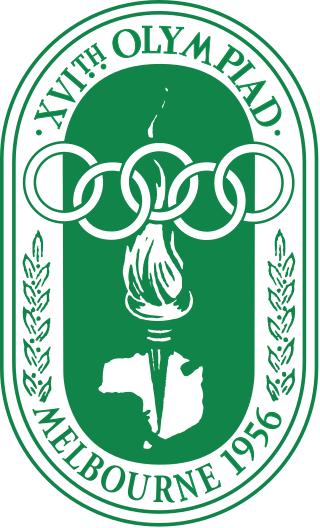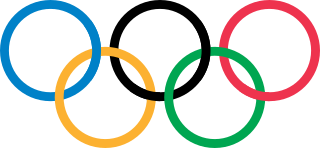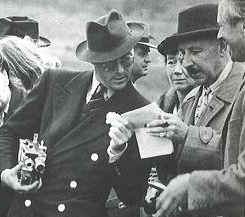
The 1956 Summer Olympics, officially the Games of the XVI Olympiad and officially branded as Melbourne 1956, were an international multi-sport event held in Melbourne, Victoria, Australia, from 22 November to 8 December 1956, with the exception of the equestrian events, which were held in Stockholm, Sweden, in June 1956.

The 1912 Summer Olympics, officially known as the Games of the V Olympiad and commonly known as Stockholm 1912, were an international multi-sport event held in Stockholm, Sweden, between 5 May and 22 July 1912. The opening ceremony was held on 6 July.
This is the full table of the medal table of the 1956 Summer Olympics in Melbourne, Australia and Stockholm, Sweden.

National Olympic Committees that wish to host an Olympic Games select cities within their territories to put forth bids for the Olympic Games. The staging of the Paralympic Games is automatically included in the bid. Since the creation of the International Olympic Committee (IOC) in 1894, which successfully appropriated the name of the Ancient Greek Olympics to create a modern sporting event, interested cities have rivaled for selection as host of the Summer or Winter Olympic Games. 51 different cities have been chosen to host the modern Olympics: three in Eastern Europe, five in East Asia, one in South America, three in Oceania, nine in North America and all the others in Western Europe. No Central American, African, Central Asian, Middle Eastern, South Asian, or Southeast Asian city has ever been chosen to host an Olympics.

The equestrian events at the 1956 Summer Olympics were held in Stockholm due to the Australian quarantine regulations and included dressage, eventing, and show jumping. All three disciplines had both individual and team competitions. The competitions were held from 11 to 17 June 1956 at Stockholm Olympic Stadium. There were 158 entries from 29 National Olympic Committees: Argentina, Australia, Austria, Belgium, Brazil, Bulgaria, Cambodia, Canada, Denmark, Egypt, Finland, France, Germany, Great Britain, Hungary, Ireland, Italy, Japan, Netherlands, Norway, Portugal, Romania, Soviet Union, Spain, Sweden, Switzerland, Turkey, USA and Venezuela. This would be the first appearance for Australia, Cambodia and Venezuela in equestrian events.

Switzerland has sent athletes to compete in every Games since it first participated at the Olympic Games at the inaugural 1896 Games. Switzerland boycotted the 1956 Summer Olympics events held in Melbourne in protests of the Soviet invasion of Hungary, but participated in the equestrian events for those Games held in Stockholm, Sweden earlier that year, where the Swiss dressage team won the bronze medal.

Spain first participated at the Olympic Games in 1900, and has sent athletes to compete in most Summer Olympic Games since 1920. Spain has also participated in every Winter Olympic Games since 1936. Its team is organised by the Spanish Olympic Committee created in 1924.

Cambodia competed in the Olympic Games for the first time at the 1956 Summer Olympics. Because Cambodia decided to join the boycott over the participation of the Soviet Union, who invaded Hungary during the USSR's invasion of Hungary, the nation did not send any athletes to Melbourne, Australia where all but equestrian events were held in late November, and early December. To accommodate Australia's strict animal quarantine regulations, Dressage, Eventing, and Show Jumping were held in June at Stockholm Olympic Stadium. Two Cambodian riders, Isoup Ganthy, and Saing Pen, competed in the equestrian events.

Egypt boycotted the 1956 Summer Olympics in Melbourne, Australia, because of the participation of the Soviet Union, who invaded Hungary during the USSR's invasion of Hungary. The equestrian events for the 1956 Games, however, were held in Stockholm, Sweden, five months earlier, due to Australian quarantine regulations, and three Egyptian riders competed in the show jumping events. None of the athletes won individual medals and they failed to place in the team competition due to one rider's failure to finish the individual tournament.

Norway competed at the 1956 Summer Olympics in Melbourne, Australia and Stockholm, Sweden. 22 competitors, 19 men and 3 women, took part in 18 events in 6 sports.

Hungary competed at the 1956 Summer Olympics in Melbourne, Australia, and Stockholm, Sweden. 108 competitors, 88 men and 20 women, took part in 80 events in 12 sports.

The Netherlands boycotted the 1956 Summer Olympics in Melbourne, Australia because of the participation of the Soviet Union, who invaded Hungary during the USSR's invasion of Hungary. However, the equestrian events for the 1956 Games were held in Stockholm, Sweden five months earlier, and one Dutch rider competed.

Spain boycotted the 1956 Summer Olympics in Melbourne, Australia because of the participation of the Soviet Union, who invaded Hungary during the USSR's invasion of Hungary. However, the equestrian events for the 1956 Games were held in Stockholm, Sweden five months earlier, and six Spanish riders competed.

Gustaf Adolf "Gösta" Boltenstern Jr. was a Swedish officer and horse rider who competed at the 1932, 1948, 1952 and 1956 Summer Olympics.

Egypt first participated at the Olympic Games in 1912, and has sent athletes to compete in most editions of the Summer Olympic since then. Along with Cambodia, Iraq and Lebanon, Egypt boycotted the 1956 Summer Olympics in protest of the tripartite Israeli, British, and French invasion of Egypt in the Suez War. However, the equestrian events for the 1956 Games were held in Stockholm, Sweden five months earlier, and three Egyptian riders competed there. Egypt withdrew from the 1976 Summer Olympics after three days of competition to join the broad African boycott in response to the participation of New Zealand, who still had sporting links with apartheid South Africa. Egypt also participated in the American-led boycott of the 1980 Summer Olympics in protest of the Soviet Union's invasion of Afghanistan. Egypt's lone participation at the Winter Olympic Games was a single alpine skier in 1984.

Gehnäll Persson was a Swedish Army fanjunkare and equestrian.
For the 1956 Summer Olympics, events were staged in a total of thirteen sports venues in Melbourne, Victoria, one in Ballarat, Victoria, and three sports venues in Stockholm, Sweden. The equestrian events took place in Stockholm in June 1956, due to Australia's strict quarantine laws on equestrianism, and the other Olympic events took place in Melbourne later in the year, between late November and early December.

Alexis "Tschuli" Pantchoulidzew was a Russian-born Dutch nobleman and equestrian. He was a long-term partner of Princess Armgard of Sierstorpff-Cramm and mentor to her son, Prince Bernhard of Lippe-Biesterfeld. As equestrian, he was the only competitor for the Netherlands at the Dutch-boycotted 1956 Summer Olympics; aged 67, he was also the eldest participant at those Olympics and the eldest Dutch Olympian ever.
















